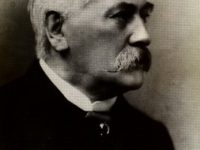
This famous scene from the north wall of Medinet Habu is often used to illustrate the Egyptian campaign against the Sea Peoples in what has come to be known as the Battle of the Delta
On June 23, 1846, French egyptologist Gaston Camille Charles Maspero was born. Maspero is best known for popularizing the term “Sea Peoples“. He was director general of excavations and antiquities for the Egyptian government, who was responsible for locating a collective royal tomb of prime historic importance.
Studying Egyptology under Auguste Mariette
Gaston Maspero studied at the École normale and met Egyptologist Auguste Mariette in 1867, back then the commissioner for the Egyptian section of the Exposition universelle in Paris.[4] When Mariette gave Maspero two newly discovered hieroglyphic texts of considerable difficulty to study, the young scholar was able to translate them quickly. After publishing the texts during that year, Gaston Maspero was able to establish his academic reputation. During 1869, Maspero became a teacher of Egyptian language and archeology at the École pratique des hautes études. In 1874 he was appointed to the chair of Champollion at the Collège de France, succeeding Emmanuel de Rougé.[5]
The Sea People
The Sea Peoples were a purported seafaring confederation of groups known to have attacked ancient Egypt and other regions of the East Mediterranean prior to and during the Late Bronze Age collapse (1200–900–BCE). Even though their origin is unclear, the various Sea Peoples have been proposed to have originated from places that include western Asia Minor, the Aegean, the Mediterrannean islands and Southern Europe. Even though there is only little evidence, the Sea peoples are believed to have sailed around the eastern Mediterranean and invaded Anatolia, Syria, Canaan, Phoenicia, Cyprus, and Egypt toward the end of the Bronze Age.
The Battles of Rameses II
The concept of the Sea Peoples was first described by Emmanuel de Rougé in 1855. He was back then the curator of the Louvre and in his work ‘Note on Some Hieroglyphic Texts Recently Published by Mr. Greene‘, Rougé explained the battles of Ramesses III described on the Second Pylon at Medinet Habu, and based upon recent photographs of the temple by John Beasley Greene. The scientist then noted that “in the crests of the conquered peoples the Sherden and the Teresh bear the designation of the ‘peuples de la mer'”, in a reference to the prisoners depicted at the base of the Fortified East Gate. When Rougé published his ‘Excerpts of a mémoire on the attacks directed against Egypt by the peoples of the Mediterranean in the 14th century BCE‘ in 1867 he mainly focuses on the battles of Ramesses II and Merneptah. When Rougé was appointed chair of Egyptology at the Collège de France, Maspero took over his position and Maspero continued Rougé’s work.[8]
The Struggle of the Nations
‘The Struggle of the Nations‘ was published in 1895-1896 and in it, Gaston Maspero described the theory of the seaborne migrations in detail for a wide audience. Maspero’s theory was taken up by other scholars such as Eduard Meyer, and became the generally accepted theory amongst Egyptologists and orientalists. However, since the 1990s, it has been brought into question by a number of scholars.
Succeeding Mariette
In 1880 Maspero travelled to the Valley of the Kings for the first time on a French archaeological mission to Egypt. In 1881, after Mariette’s death, Maspero was appointed to succeed him in the Egyptian Service of the Antiquités de l’Égypte and the Bulaq Museum, now the Egyptian Museum in Cairo. He held this office first until 1886, then again from 1899 until his retirement in 1914. In 1883 he was elected a full member of the Académie des Inscriptions et Belles-Lettres.
Later Life
Throughout his life Maspero researched all over Egypt. With Emile Brugsch he discovered the first pyramid texts (1881), was in office at the discovery of the royal mummies in Deir el-Bahari (Cachette of Deir el-Bahari) and organized the scientific service of antiquity in Egypt. Maspero was the first to catalogue the objects in the Egyptian Museum in Cairo, founded the Catalogue général des antiquités égyptiennes du Musée du Caire in 1900 and was subsequently the editor of the first 50 volumes of this publication. This work and the increasing workload of the Antiquities Service led to an expansion of staff at the museum, including the 17-year-old Howard Carter. It was Maspero who recommended Carter to George Herbert, 5th Earl of Carnarvon in 1907, when the Earl approached him to seek advice for the use of an expert to head his planned archaeological expedition to the Valley of the Kings.[7]
Gaston Maspero died on June 30, 1916, at age 70.
1177 BC: The Year Civilization Collapsed (Eric Cline, PhD), [9]
References and Further Reading:
- [1] Gaston Maspero at the New World Encyclopedia
- [2] Gaston Maspero at Britannica Online
- [3] Who Where the Sea Peoples?
- [4] Auguste Mariette and the Serapeum, SciHi Blog
- [5] Cracking the Code – Champollion and the Rosetta Stone, SciHi Blog
- [6] Gaston Maspero at Wikidata
- [7] Howard Carter and the Tomb of Tutankhamun, SciHi Blog
- [8] Ramesses II – King of Kings am I, SciHi Blog
- [9] 1177 BC: The Year Civilization Collapsed (Eric Cline, PhD), NCASVideo @ youtube
- [10] Jastrow, Jr., Morris (1916). “Sir Gaston Maspero”. Proceedings of the American Philosophical Society. Philadelphia: American Philosophical Society. 55 (8): III–XIII.
- [11] Chisholm, Hugh, ed. (1911). “Maspero, Gaston Camille Charles“. Encyclopædia Britannica. Vol. 17 (11th ed.). Cambridge University Press. p. 848.
- [12] Drower, Margaret S. (1982). “Gaston Maspero and the Birth of the Egypt Exploration Fund (1881-3)”. The Journal of Egyptian Archaeology. Sage Publications. 68: 299–317.
- [13] Timeline of French Egyptologists, via DBpedia and Wikidata






Pingback: Whewell’s Gazette: Year 3, Vol. #45 | Whewell's Ghost